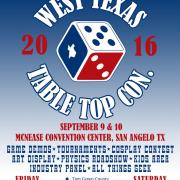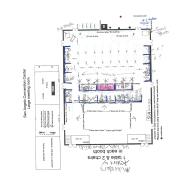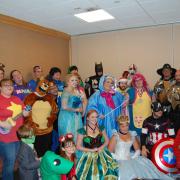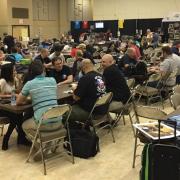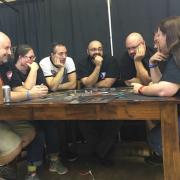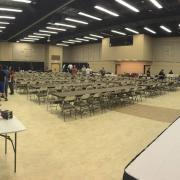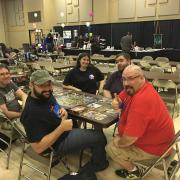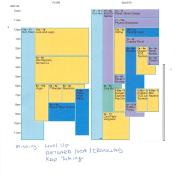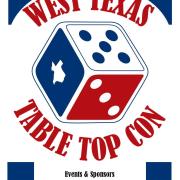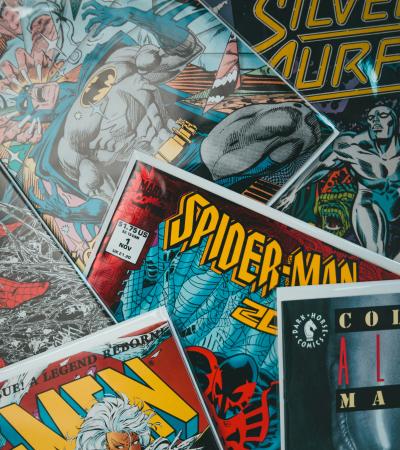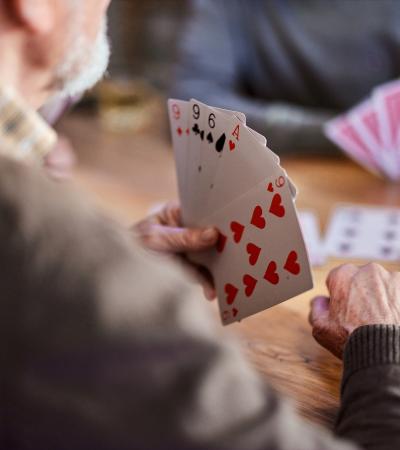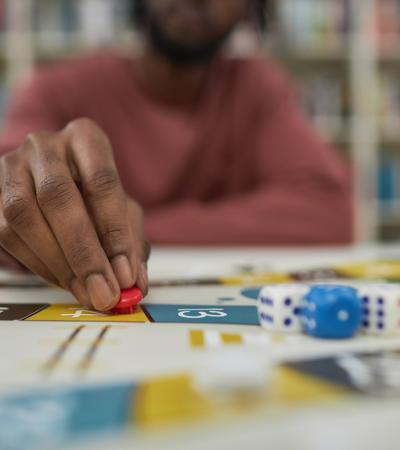The Tom Green County Library System began a tabletop gaming program three years ago to build community and provide a fun activity for all ages. Out of that program grew the West Texas Table Top Convention (WT3C), an annual library-sponsored event intent on celebrating not only tabletop games, but all aspects of geek culture.
The event seeks to unite the various facets of geek culture within our community by providing space, time, opportunity and programs for sharing and celebrating our individual geekiness in a safe, family-friendly environment.
Advanced Planning
To get started, we reached out to groups beyond the “traditional” line of outreach partners for libraries: FLGS (friendly local game stores); local gaming group, San Angelo Nerdery; Friends of the Library; Youtube gaming channel PubMeeple; and the creator of the largest international Facebook tabletop gaming group, The Board Game Group. We also involved other groups of a geeky-nerdy bent: AMTGARD, Society for Creative Anachronism, Ironclad Tournament League and cosplayers.
The goal of the program was to build community through tabletop gaming, and promote gaming as a mechanism for improving social skills, literacy and creative thinking. We began planning one year in advance and established a committee made up of volunteers from the local gaming community, FLGS and our Friends group. We established a budget, date and secured space. Next, we reached out to board game designers and industry leaders to get leaders in the board gaming world that would make people in the region want to attend.
We encountered a few unexpected challenges: a Comic Con (for profit) set a date in our community approximately two weeks after our event, which created some confusion, and an industry-only convention put on by a major game distributor prevented many publishers we contacted from being able to attend.
Marketing
We marketed primarily through social media, Youtube, the library website, gamer-specific websites, and fliers and other print materials posted throughout the community. We created our own hashtag (#WT3C) and asked attendees to use that hashtag for their social media posts. It was successful, as a search for that will bring up quite a bit of social media content on Instagram and Twitter.
The social media campaign also involved paid promotions and by far had the largest impact. We worked with our local newspaper, The Standard Times, which crafted a social media campaign for us to promote the convention throughout the region—about a 200-mile radius. This was a fee service and saved us an enormous amount of time, so that we could focus on the event. The cost was steep, but it was also effective.
Several of the podcasters and Youtube tabletop game reviewers and promoters posted videos and podcasts about the convention ahead of the events and reviewed the convention afterward. As these individuals have an international audience, their promotion was extremely effective. After each video or podcast, we could see a spike in traffic on the website and Facebook page.
Budgeting
We spent approximately $5,000 our first year, primarily for travel, speaker fees and advertising. We spent $13,000 for year two. The largest expense for the second year was a facility rental — approximately $4,000. The remainder of the budget went to travel, speaker fees, advertising, t-shirts for volunteers and wristbands for entry.
Our first year we had approximately 400 attendees. We anticipated about 150. Our facility, a 3,000-square-foot community room, really could not accommodate that many people comfortably. We learned an important lesson: make the event ticketed, even if it is free, or get a larger facility. We opted for a larger facility. For year two, we rented the local convention center’s main ballroom and one side room — approximately 12,000 square feet — and our attendance increased to 550 people.
While the cost of this event was significant, it was also well attended. It can, however, be done significantly cheaper. We are a remote community. We wanted our attendees, and our community, to get to meet and interact with modern board game designers and industry leaders and personalities. By far, our largest expense was travel and speaking fees for these individuals. If your area is fairly urban, chances are good that these individuals are already within your community, and most love to share their hobby with others. If the region is rural, as ours is, having VIP guests is nice, and an inducement for people to travel to the event, but most of our guests attended for the opportunity to play games with a diverse group of people in a spacious environment with plenty of good tables.
Day-of-event Activity
Set-up consisted of ensuring tables, chairs and vendor booths were set up, the clues for the Escape Room were in their appropriate places, the children’s area activities were in place and all supplies were available to volunteers, the play-to-win games were punched and ready to go, and the library’s collection of tabletop games were organized and checked for missing parts and pieces.
Because of all the pre-planning, the event itself ran smoothly with minimal set-up. Volunteers were trained as each shift arrived. The only unexpected challenge dealt with our programming schedule. We had to make some adjustments to the schedule as we had events scheduled too closely together and a few ran over time.
Program Execution
We had 550 people attend the event, and all the feedback we received was positive, with the exception of a single vendor who did not meet his target revenue goal.
Our goal was to surpass the previous year’s attendance and provide a fun community event, which we met.
We opened the event at noon on Friday and initially worried that we would have poor attendance as we were just not seeing many people arrive; however, attendance picked up as people got off work and out of school after 5 p.m. We kept the Friday schedule light, assuming Saturday would be the big day. (View the full schedule under Attachments at right.)
Saturday, we opened with a Physics Roadshow from our local university student physics society, and that was a huge hit with children and families. We had a board game design panel, followed by a cosplay panel, then a game review/content creator panel. This is where we utilized our special guests, and while we had a steady audience for each event, attendance at the panels was low. Our primary audience came to play games and interact with one another, and the guests, over games.
In addition to the tabletop gaming aspect of the convention, we also provided space for AMTGARD, SCA and Ironclad Tournament League to demonstrate Medieval Combat and arts and sciences from the middle ages, and these events were extremely popular with children and families.
Finally, we offered a cosplay contest and brought in several area cosplayers as guests to judge the contest and discuss the creation of costumes and characters for cosplay. While the panel was not well attended, the contest was, and it was a lot of fun for the judges, participants and audience.
We ended Saturday evening with a drawing for all the play-to-win games and raffles and a few final games.
Advice
Before attempting a convention, build your gaming community first. I worked with the gamers in my community for a year, as well as the friendly local game stores, to build a community base that would support the convention. Establishing a reputation as a fun, safe place for gamers to play was critical to getting the attendance at the event.
Second, research to find publishers, designers and online personalities from the gaming community in your area and invite them. Offer space to playtest games. Try to bring in one special guest from within the industry to provide an educational component or just to interact with the audience. Just as readers like to interact with the author of their favorite novel, board gamers enjoy interacting with their favorite game designer.
Consider other geeky/nerdy groups in your community that might also be looking for a fresh audience and include them if space is available. We provided space and activities for our local science societies, LARP groups, RPGers, video gamers and cosplay. Many of them played games, and all reported boosts in their membership afterward.
Offering plenty of tables and chairs, good lighting, and food and drink available for sale on site, made all of our attendees very happy. I believe these very simple things are the essential elements to a successful board game convention.

